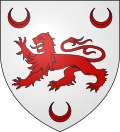Alaigne
Geography
The commune is located some 10 km north-west of Limoux and 20 km east of Mirepoix. A number of district roads all converge on the village of Alaigne: the D102 south from Belvèze-du-Razès, the D702 west from Routier, the D102 north-west from Limoux, and the D52 which comes east from Bellegarde-du-Razès then continues south to Villelongue-d'Aude.
The village itself is a traditional Circulade located in the historical region of Razès.
Located in the AOP Malepere wine growing area, the commune is mostly vineyards and farmland for wheat, rape and sunflowers with a few scattered forests. There are no villages or hamlets other than Alaigne.
Neighbouring communes and towns
Heraldry
 |
This is the arms of the last Archbishop of Narbonne, Arthur Richard Dillon.
The communes of Bize-Minervois, Gruissan, Pieusse, and Routier which were also strongholds of the Archbishop of Narbonne have the same arms. Blazon:
|
History
Before the Revolution, Alaigne was a part of Pieusse and Routier was a barony of the Archbishop of Narbonne.
Administration
List of Successive Mayors of Alaigne
| From | To | Name | Party | Position |
|---|---|---|---|---|
| 1906 | 1912 | Urbain Frontil | General Councillor | |
| 2001 | 2026 | Jean Périllou |
Population
The inhabitants of the commune are known as Alaignois or Alaignoises in French.
| Year | Pop. | ±% p.a. |
|---|---|---|
| 1968 | 385 | — |
| 1975 | 366 | −0.72% |
| 1982 | 330 | −1.47% |
| 1990 | 290 | −1.60% |
| 1999 | 300 | +0.38% |
| 2007 | 337 | +1.46% |
| 2012 | 343 | +0.35% |
| 2017 | 326 | −1.01% |
| Source: INSEE | ||
Culture and heritage
Civil heritage
Religious heritage
- The Cemetery contains a number of items that are registered as historical objects:
- The Parish Church of Saint-Pierre es Liens contains a number of items that are registered as historical objects:
See also
References
- ^ "Répertoire national des élus: les maires". data.gouv.fr, Plateforme ouverte des données publiques françaises (in French). 2 December 2020.
- ^ "Populations de référence 2022" (in French). The National Institute of Statistics and Economic Studies. 19 December 2024.
- ^ Google Maps
- ^ Arms of the State of Languedoc, editor Jacques Vincent, by Denis-François Gastelier de La Tour, 1767, Paris, 248 pages (in French)
- ^ Topographic Dictionary of the départment of Aude, Imprimerie nationale, Abbot Antoine Sabarthès, 1912, Paris, p. 313.
- ^ List of Mayors of France (in French)
- ^ Le nom des habitants du 11 - Aude, habitants.fr
- ^ Population en historique depuis 1968, INSEE
- ^ Ministry of Culture, Mérimée PA00102510 Porte de Papi Fortified door (in French)

- ^ Ministry of Culture, Palissy PM11002570 Funeral Stèle (in French)
- ^ Ministry of Culture, Palissy PM11002569 Funeral Stèle (in French)
- ^ Ministry of Culture, Palissy PM11002568 Funeral Stèle (in French)
- ^ Ministry of Culture, Palissy PM11002567 2 Funeral Stèles (in French)
- ^ Ministry of Culture, Palissy PM11002572 Chalice with Paten (in French)
- ^ Ministry of Culture, Palissy PM11002571 Chalice with Paten (in French)
- ^ Ministry of Culture, Palissy PM11002566 2 Stoups (in French)
- ^ Ministry of Culture, Palissy PM11002565 Facing of the Altar and the communion table (in French)
- ^ Ministry of Culture, Palissy PM11002579 Reliquary Cross of Saint Julie (in French)
External links
- Alaigne on the National Geographic Institute website
- Alaigne on Géoportail, National Geographic Institute (IGN) website (in French)
- Alaigne on the 1750 Cassini Map